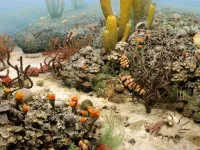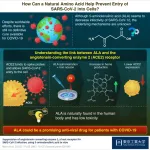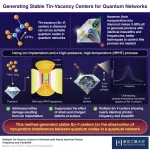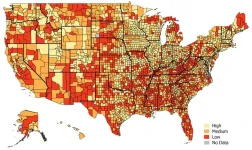(Press-News.org) Researchers from the UCL Cancer Institute have provided important molecular understanding of how injury may contribute to the development of a relatively rare but often aggressive form of brain tumour called a glioma.
Previous studies have suggested a possible link between head injury and increased rates of brain tumours, but the evidence is inconclusive. The UCL team have now identified a possible mechanism to explain this link, implicating genetic mutations acting in concert with brain tissue inflammation to change the behaviour of cells, making them more likely to become cancerous. Although this study was largely carried out in mice, it suggests that it would be important to explore the relevance of these findings to human gliomas.
The study was led by Professor Simona Parrinello (UCL Cancer Institute), Head of the Samantha Dickson Brain Cancer Unit and co-lead of the Cancer Research UK Brain Tumour Centre of Excellence. She said: “Our research suggests that a brain trauma may contribute to an increased risk of developing brain cancer in later life."
Gliomas are brain tumours that often arise in neural stem cells. More mature types of brain cells, such as astrocytes, have been considered less likely to give rise to tumours. However, recent findings have demonstrated that after injury astrocytes can exhibit stem cell behaviour again.
Professor Parrinello and her team therefore set out to investigate whether this property may make astrocytes able to form a tumour following brain trauma using a pre-clinical mouse model.
Young adult mice with brain injury were injected with a substance which permanently labelled astrocytes in red and knocked out the function of a gene called p53 – known to have a vital role in suppressing many different cancers. A control group was treated the same way, but the p53 gene was left intact. A second group of mice was subjected to p53 inactivation in the absence of injury.
Professor Parrinello said: "Normally astrocytes are highly branched – they take their name from stars – but what we found was that without p53 and only after an injury the astrocytes had retracted their branches and become more rounded. They weren’t quite stem cell-like, but something had changed. So we let the mice age, then looked at the cells again and saw that they had completely reverted to a stem-like state with markers of early glioma cells that could divide.”.
This suggested to Professor Parrinello and team that mutations in certain genes synergised with brain inflammation, which is induced by acute injury and then increases over time during the natural process of ageing to make astrocytes more likely to initiate a cancer. Indeed, this process of change to stem-cell like behaviour accelerated when they injected mice with a solution known to cause inflammation.
The team then looked for evidence to support their hypothesis in human populations. Working with Dr Alvina Lai in UCL’s Institute of Health Informatics, they consulted electronic medical records of over 20,000 people who had been diagnosed with head injuries, comparing the rate of brain cancer with a control group, matched for age, sex and socioeconomic status. They found that patients who experienced a head injury were nearly four times more likely to develop a brain cancer later in life, than those who had no head injury. It is important to keep in mind that the risk of developing a brain cancer is overall low, estimated at less than 1% over a lifetime, so even after an injury the risk remains modest.
Professor Parrinello said: “We know that normal tissues carry many mutations which seem to just sit there and not have any major effects. Our findings suggest that if on top of those mutations, an injury occurs, it creates a synergistic effect. In a young brain, basal inflammation is low so the mutations seem to be kept in check even after a serious brain injury. However, upon ageing, our mouse work suggests that inflammation increases throughout the brain but more intensely at the site of the earlier injury. This may reach a certain threshold after which the mutation now begins to manifest itself.”
The study is published in the journal Current Biology and involved researchers from the UCL Cancer Institute, UCL Laboratory for Molecular Cell Biology and UCL Institute of Health Informatics alongside external collaborators from Imperial College London – with funding provided by Cancer Research UK, the Oli Hildson foundation through the Brain Tumour Charity and the MRC.
END
Head injuries could be a risk factor for developing brain cancer
Researchers from the UCL Cancer Institute have provided important molecular understanding of how injury may contribute to the development of a relatively rare but often aggressive form of brain tumour called a glioma.
2023-02-24
ELSE PRESS RELEASES FROM THIS DATE:
New study reveals biodiversity loss drove ecological collapse after the “Great Dying”
2023-02-24
SAN FRANCISCO, CA (February 24, 2023) — The history of life on Earth has been punctuated by several mass extinctions, the greatest of these being the Permian-Triassic extinction event, also known as the “Great Dying”, which occurred 252 million years ago. While scientists generally agree on its causes, exactly how this mass extinction unfolded—and the ecological collapse that followed—remains a mystery. In a study published today in Current Biology, researchers analyzed marine ecosystems before, during, and after the Great Dying ...
Differences in animal biology can affect cancer drug development
2023-02-24
A small but significant metabolic difference between human and mouse lung tumor cells, has been discovered by Weill Cornell Medicine researchers, explaining a discrepancy in previous study results, and pointing toward new strategies for developing cancer treatments.
The work, published Jan. 30 in Cancer Discovery, focuses on lung adenocarcinoma, a common but often difficult to treat cancer that researchers have long studied in mouse models. However, those models didn’t quite align with human clinical observations in some instances. The new paper shows why; a specific gene mutation has opposite effects on tumor ...
Manchester research captures and separates important toxic air pollutant
2023-02-24
Led by scientists at The University of Manchester, a series of new stable, porous materials that capture and separate benzene have been developed. Benzene is a volatile organic compound (VOC) and is an important feedstock for the production of many fine chemicals, including cyclohexane. But, it also poses a serious health threat to humans when it escapes into the air and is thus regarded as an important air pollutant.
The research published today in journal Chem, demonstrates the high adsorption of benzene at low pressures and concentrations, as well as the efficient separation of benzene and cyclohexane. This was achieved by the design and successful preparation ...
Using the power of artificial intelligence, new open-source tool simplifies animal behavior analysis
2023-02-24
Graphic
A team from the University of Michigan has developed a new software tool to help researchers across the life sciences more efficiently analyze animal behaviors.
The open-source software, LabGym, capitalizes on artificial intelligence to identify, categorize and count defined behaviors across various animal model systems.
Scientists need to measure animal behaviors for a variety of reasons, from understanding all the ways a particular drug may affect an organism to mapping how circuits in the brain communicate to produce a particular behavior.
Researchers ...
WHO and ESCEO announce collaborative agreement to benefit global osteoporosis and fracture prevention
2023-02-24
The World Health Organization (WHO) and the European Society for Clinical and Economic Aspects of Osteoporosis, Osteoarthritis and Musculoskeletal Diseases (ESCEO) signed an agreement to develop a strategic roadmap on bone health and ageing and advocate for a public health strategy to prevent fractures among older people. The collaboration entails a strategic roadmap of research and publication deliverables, in recognition of the fact that osteoporosis is a major contributor to the Global Burden of Disease.
The collaboration agreement, signed on February 23, 2023, at WHO Headquarters in Geneva, Switzerland, is an important ...
Discovery suggests new way to prevent common causes of vision loss
2023-02-24
UVA Health scientists have discovered an unknown contributor to harmful blood vessel growth in the eye that could lead to new treatments for blinding macular degeneration and other common causes of vision loss.
UVA’s Jayakrishna Ambati, MD, and Shao-bin Wang, PhD, and their colleagues have identified a new target to prevent the formation of abnormal tangles of blood vessels associated with eye conditions such as neovascular age-related macular degeneration, proliferative diabetic retinopathy and ischemic retinal vein occlusion.
“Our study has opened up the possibility of mitigating ...
Could a naturally occurring amino acid lead us to a cure for COVID-19?
2023-02-24
After more than two years since its discovery, six million deaths, and half a billion reported cases, there is still no effective cure for COVID-19. Even though vaccines have lowered the impact of outbreaks, patients that contract the disease can only receive supportive care while they wait for their own body to clear the infection.
A promising COVID-19 treatment strategy that has been gaining traction lately is targeting angiotensin-converting enzyme 2 (ACE2). This is a receptor found on the cell membrane that allows entry of the virus into the cell due to its ...
Breakthrough in tin-vacancy centers for quantum network applications
2023-02-24
Quantum entanglement refers to a phenomenon in quantum mechanics in which two or more particles become linked such that the state of each particle cannot be described independently of the others, even when they are separated by a large distance. The principle, referred to by Albert Einstein as "spooky action at a distance", is now utilized in quantum networks to transfer information. The building blocks of these networks—quantum nodes—can generate and measure quantum states.
Among the candidates that can function as ...
Low income, race, and rural residence among risk factors for low telemedicine literacy
2023-02-24
February 24, 2023 – Demographic factors including low income and living in a rural area are linked to low telemedicine literacy – which may limit access to plastic surgeons and other healthcare providers at a time of expanding use of telehealth and video visits, according to a report in the March issue of Plastic and Reconstructive Surgery®, the official medical journal of the American Society of Plastic Surgeons (ASPS). The journal is published in the Lippincott portfolio by Wolters Kluwer.
"Our ...
Risk of cancer remains high for women over 50 with genetic BRCA1 or BRCA2 mutation
2023-02-24
Although genetic mutations in BRCA1 or BRCA2 are associated with a younger onset of breast and ovarian cancer, women with these genetic mutations continue to face a high risk of cancer incidence after age 50, even if they have not been previously diagnosed with cancer. This is according to a new study led by Kelly Metcalfe, a professor at the Lawrence S. Bloomberg Faculty of Nursing.
The study published recently in the American Cancer Society Journal Cancer, followed over 2000 women between the ages of 50 to 75, from 16 countries, who were aware they had a BRCA mutation ...
LAST 30 PRESS RELEASES:
New study overturns long-held model of how plants coordinate immune responses.
New AI model predicts disease risk while you sleep
Scientists discover molecular ‘reshuffle’ and crack an 80-year-old conundrum
How stressors during pregnancy impact the developing fetal brain
Electrons lag behind the nucleus
From fungi to brain cells: one scientist's winding path reveals how epigenomics shapes neural destiny
Schizophrenia and osteoporosis share 195 genetic loci, highlighting unexpected biological bridges between brain and bone
Schizophrenia-linked genetic variant renders key brain receptor completely unresponsive to both natural and therapeutic compounds
Innovative review reveals overlooked complexity in cellular energy sensor's dual roles in Alzheimer's disease
Autism research reframed: Why heterogeneity is the data, not the noise
Brazil's genetic treasure trove: supercentenarians reveal secrets of extreme human longevity
The (metabolic) cost of life
CFRI special issue call for papers: New Frontiers in Sustainable Finance
HKU Engineering scholar demonstrates the smallest all-printed infrared photodetectors to date
Precision empowerment for brain "eavesdropping": CAS team develops triple-electrode integrated functional electrode for simultaneous monitoring of neural signals and chemical transmitters during sleep
Single-capillary endothelial dysfunction resolved by optoacoustic mesoscopy
HKU three research projects named among ‘Top 10 Innovation & Technology News in Hong Kong 2025’ showcasing excellence in research and technology transfer
NLRSeek: A reannotation-based pipeline for mining missing NLR genes in sequenced genomes
A strand and whole genome duplication–aware collinear gene identification tool
Light storage in light cages: A revolutionary approach to on-chip quantum memories
Point spread function decoupling in computational fluorescence microscopy
BacPhase: Long-insert paired-end sequencing for bin marker construction and genome phasing
GmWOX1 regulates the mediolateral polarity of compound leaves in soybean
ChargeFabrica: An open-source simulation tool that aims to accelerate search for high performance perovskite solar cells
High levels of ADAR overexpression induce abundant and stochastic off-target RNA editing in rice protoplasts
On-demand upgraded recycling of polyethylene and construction of sustainable multifunctional materials based on the "LEGO" strategy
New "Stomata in-sight" system allows scientists to watch plants breathe in real-time
Anorexia nervosa may result in long-term skeletal muscle impairment
Narrative-based performance reviews deemed fairest by employees
New insights reveal how advanced oxidation can tackle emerging water pollutants
[Press-News.org] Head injuries could be a risk factor for developing brain cancerResearchers from the UCL Cancer Institute have provided important molecular understanding of how injury may contribute to the development of a relatively rare but often aggressive form of brain tumour called a glioma.





